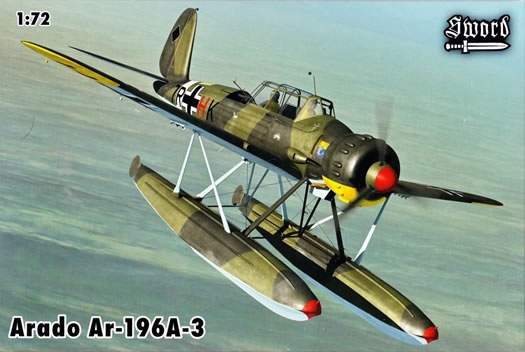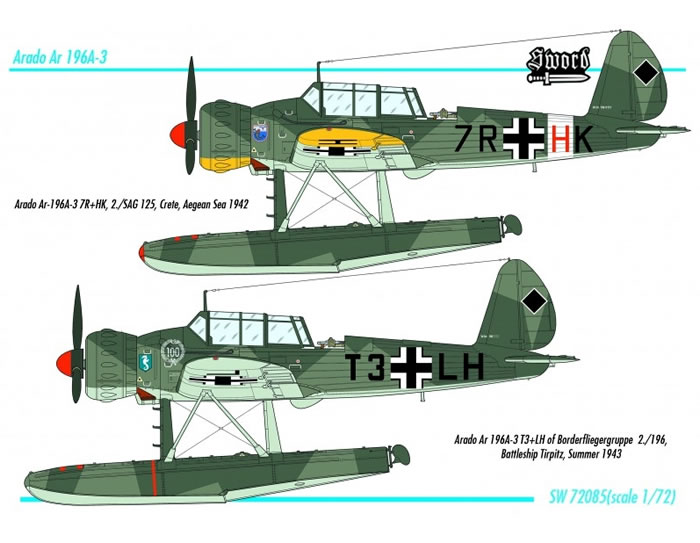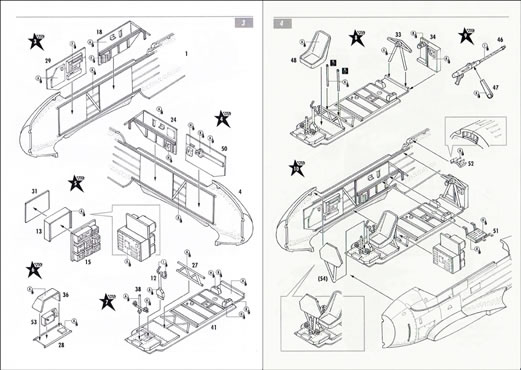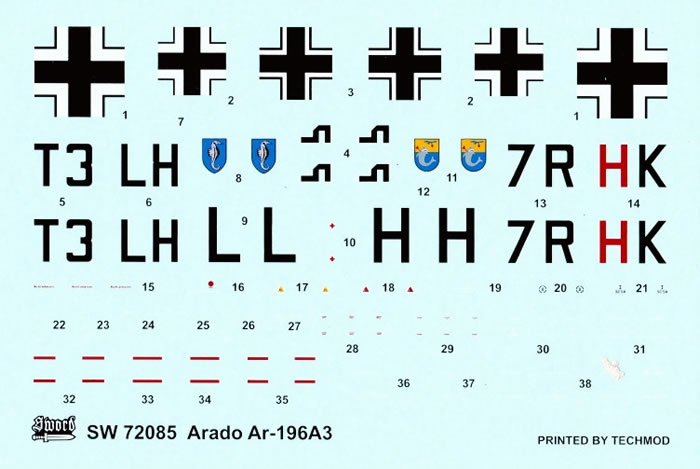Arado Ar 196 A-3

Sword, 1/72 scale
S u m m a r y |
Catalogue Numbers: |
Sword Kit No. SW72085 – Arado Ar 196A-3 |
Scale: |
1/72 |
Contents & Media: |
66 grey and four clear styrene parts; one resin piece; decals for two subjects. |
Price: |
Available on-line from these stockists: |
West Coast Hobbys |
Hannants |
Squadron |
Modelimex |
HLJ |
Can$23.00 |
£12.49 |
US$35.09 |
€14.46 |
¥2,520 |
Click here for currency conversion. |
Review Type: |
First Look. |
Advantages: |
The best 1/72 Ar 196 so far, with accurate appearance, good production quality, very nice airframe detail, and good cockpit detail. Good value too, from the right supplier. |
Disadvantages: |
None of any consequence. |
Conclusions: |
This is a worthy successor to the 35-year-old Heller kit. It has far more internal detail, very nice surface treatment, superior cowling, and better decals.
It is a very good limited-run kit, and is typical of Sword. It is accurate in appearance, well engineered, and looks about as straightforward to build as can be expected for the type.
There are a couple of minor niggles, but none that warrant specific mention in a summary.
Existing aftermarket items intended for the Heller kit are likely to suit this one too I think. I would restrict my use of such to a Falcon canopy to show off the interior better, and possibly a Quickboost propeller for added refinement. Neither of these is in any way essential however.
I am happy to declare this the best Ar 196 in 1/72 scale by far in my opinion, and I think it is also excellent value from the right supplier. I highly recommend it. |
Reviewed by
Mark Davies

Sword's 1/72 Arado Ar 196 is available online from Squadron.com
The Arado Ar 196 was a shipboard reconnaissance monoplane developed by the German firm of Arado starting in 1936. The next year it was selected as the winner of a design contest and became the standard aircraft of the Kriegsmarine (German navy) throughout World War II.
The Ar 196 prototypes were all delivered in summer 1937, V1 (which flew in May) and V2 with twin floats as A models, and V3 and V4 on a single float as B models. Both versions demonstrated excellent water handling and there seemed to be little to decide one over the other. Since there was a possibility of the smaller outrigger floats on the B models "digging in", the twin-float A model was ordered into production. A single additional prototype, V5, was produced in November 1938 to test final changes.
10 A-0s were delivered in November and December 1938, with a single 7.92 mm (.312 in) MG 15 machine gun in the rear seat for defense. Five similarly equipped B-0s were also delivered to land-based squadrons. This was followed by 20 A-1 production models starting in June 1939, enough to equip the surface fleet.

Starting in November, production switched to the heavier land-based A-2 model. It added shackles for two 50 kg (110 lb) bombs, two 20 mm MG FF cannons in the wings, and a 7.92 mm (.312 in) MG 17 machine gun in the cowling. The A-4 replaced it in December 1940, strengthening the airframe, adding another radio, and switching props to a VDM model. The apparently mis-numbered A-3, which had additional strengthening of the airframe, replaced the A-4. The final production version was the A-5 from 1943, which changed radios and cockpit instruments, and switched the rear gun to the much-improved MG 81Z. Overall, 541 Ar 196s (15 prototypes and 526 production models) were built before production ended in August 1944, about 100 of these from SNCA and Fokker plants.
The Ar 196C was a proposed aerodynamically-refined version. The Ar 196C project was cancelled in 1941.
The plane was loved by its pilots, who found it handled well both in the air and on the water. With the loss of the German surface fleet, the A-1s were added to coastal squadrons and continued to fly reconnaissance missions and submarine hunts into late 1944. Two notable operations were the capture of HMS Seal, and the repeated interception of RAF Armstrong-Whitworth Whitley bombers. Although it was no match for a fighter, it was considerably better than its Allied counterparts, and generally considered the best of its class. Owing to its good handling on water, the Finnish Air Force utilized Ar 196s just for transporting and supplying special forces patrols behind enemy lines, landing on small lakes in remote areas. Several fully equipped soldiers were carried in the fuselage.
Source: Wikipedia
Previous 1/72 Scale Ar 196 Kits
Airfix released their Ar 196 kit in 1966, and was in many ways it was a kit of its time. It was possibly better than some other mid-60’s Airfix offerings, but still had a rudimentary cockpit. Good points included restrained raised surface detail for the time, and it assembled with few problems.
Heller released a far superior and more refined kit in 1979. It has also appeared re-boxed under Humbrol, Lodella, Revell, and Encore brands. This is also very much a kit of its time, dating from Heller’s heyday, and confirming for me why this French brand is still one of my favourites. It features good shape, basic internal detail, and has restrained raised panel lines. Quickboost offer a corrected and improved resin engine cowling, exhausts and prop, whilst Eduard and Aiwaves offer PE detail sets, and Falcon a vac-form canopy. A most respectable model can result OOB, and a stunner if the aftermarket parts are used.
With the Heller kit we adherents of “The One True Scale” could not really claim to be desperate for a new 1/72 Ar 196, but Sword’s new release is still most welcome. After 35 years, we are at least overdue for a more modern iteration featuring enhanced internal detail, recessed panel lines, and a cowl uncompromised by two-piece tooling. Let us see if Sword has delivered...
Contents
The kit comes in an end-opening box with digital artwork on the front.
The decals, plastic and resin parts come in a zip-lock bag, with the clear parts further enclosed in a small bag of their own.
The Instructions
The instructions provide a brief history of the aircraft, a parts map, and an easy to follow assembly format with well-drawn diagrams. Detail colour call-outs are given as generic colours in Czech and English, with all other text in English. The painting and decal guides use generally adequate black & white shaded drawings in the instructions, and colour profiles on the rear of the box. RLM codes are provided for the main airframe colours.
The Kit
This is a typical Sword kit with nicely moulded parts, fine surface detail, and reasonably narrow sprue gates. There is some flash in places, but this is easy to deal with. There are also quite a few prominent ejector stubs, fortunately in areas that cannot be e seen. Several will require removal in order for parts to fit correctly; but again, this is easily done. Parts break down is conventional for the type. The resin engine cowling is cast perfectly. The clear canopy parts are clear and acceptably thin.
Any comparison I make with Heller’s kit is from recent memory as I recently disposed of my copy in anticipation of this new Sword release.
The cockpit detail is well catered for, and is a huge improvement over the Heller kit, as the instructional images below illustrate:

The cockpit should look very good when finished and only the addition of seat harnesses needed to satisfy most people.
The fuselage captures the fabric-covered areas very nicely, whilst fine recessed lines represent the forward metal panelling. Also included are slightly curved recessed troughs. These run either side from forward of the of the pilot’s windscreen back to his canopy. Initially I wondered if these were for stowing crew boarding ropes that would hang down above the boarding steps on each forward float leg. I then found this image, which seems to show the stowed lines are for slinging the aircraft back onboard ship. Anyway, I suggest scratch building the ropes and installing them in the troughs after painting the airframe is complete. I do not know if shore-based aircraft retained these lines or not.
The clear parts are well done, as already mentioned. The canopy is in three parts, which would seem to suggest it could be modelled open. However, the instructions do not illustrate this as an option, and I do not think the pilot’s sliding portion will sit correctly over the gunner’s station. Falcon offers a vac-form canopy for the Heller kit that will likely suit this one too, should an open cockpit be desired.

The engine is quite nicely represented for the scale, with good cylinder and head shape, and separate reduction gear housing that incorporates the pushrods (as per typical Heller practice). I feel the pushrods are a tad thick, they would look better if replaced by finer rod, which should be easy enough to do. Sword appears to have left out two quite prominent round air-intakes that flank the top cylinder (see here). However, these can easily be made using a couple of punched discs and some tubing.
The resin cowl is very nice, and should be easy to remove from its casting block. The downward facing exhaust pipes include hollowed out mouths, which should look convincing with a black wash to emphasise their depth. The oil cooler intake, body and vent consist of three pieces. At first, this seems unnecessarily complicated, but I think it is for tooling reasons to ensure the required detail can be moulded using a two-piece tool.
The prop tips appear a little blunt to me when compared with photos, but these can be made more pointed with gentle sanding (or replaced with a Quickboost resin prop intended for the Heller kit). There is an angled antenna mast to mount on the windscreen, and a clear panel to fit in the upper rear fuselage decking. I cannot recall this last item as being a feature of the Heller kit.
The wings have reasonably restrained fabric effects on the flaps and ailerons, and delicate engraving for the sheet-metal panel lines. Resist any temptation to drill out the MG FF 20mm cannon barrel shrouds, which are moulded so they finish in a blunt dome shape. The real aircraft had watertight eyelid shutters to protect the cannons from spray, so Sword’s rendition of these is accurate. I noticed that the lower wing has very slight locating holes moulded for the float struts, and these seem too shallow and small for little locating pins moulded on the struts’ ends. I suggest drilling these undersize holes out for better insertion and fit. Probably best left until the end of the build are the aileron mass-balances and two bomb racks with integral sway braces (but no bombs).
The single-piece tailplane is a simple slide fit onto the rear fuselage.
To complete the airframe we are left with just the floats to examine. These will be the most demanding part of the build, as their correct alignment is essential for the model to look right, although I cannot see too many problems. The floats feature more detail on their decks than I recall with the Heller kit, including as they do handholds and fuel filler caps etc. Sword provides separate boarding steps to fit to the front float struts with locating holes let into their leading edges. I would be inclined to replace these with lengths of thin rod, as this will be easier than cleaning up the sprue gates from the kit steps. Each float has a rudder and separate hinge mechanism to add to its stern. The instructions include a float rigging diagram and a general arrangement drawing showing the strut layout.
Overall, I should think that this kit should be a simple and enjoyable one to build. My “First Look” examination leads to me to believe the kit is accurate in appearance.
Marking Options
Techmod prints the decals, and these are well registered with what appears to be good opacity. I am sure they will prove to be excellent to apply based on my experience of this brand.

The instructions provide a page of four-view drawings with the national insignia and unit markings for each of the two schemes, with colour profiles on the box rear. The subjects covered are shown below:
This is a worthy successor to the 35-year-old Heller kit. It has far more internal detail, very nice surface treatment, superior cowling, and better decals.
It is a very good limited-run kit, and is typical of Sword. It is accurate in appearance, well engineered, and looks about as straightforward to build as can be expected for the type.
There are a couple of minor niggles, but none that warrant specific mention in a summary.
Existing aftermarket items intended for the Heller kit are likely to suit this one too I think. I would restrict my use of such to a Falcon canopy to show off the interior better, and possibly a Quickboost propeller for added refinement. Neither of these is in any way essential however.
I am happy to declare this the best Ar 196 in 1/72 scale by far in my opinion, and I think it is also excellent value from the right supplier. I highly recommend it.
Thanks to West Coast Hobbys for the review sample.
Review Text & Images Copyright © 2014 by Mark Davies
Page Created 25 November, 2014
Last updated
29 December, 2014
Back to HyperScale Main Page

|
